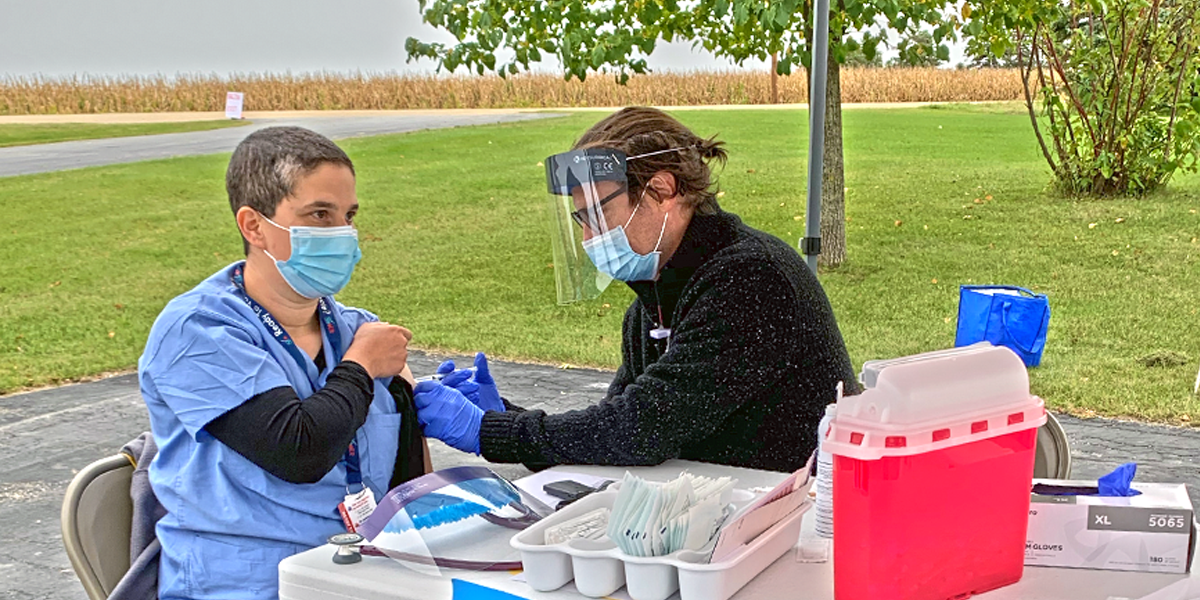
Jonathan Kirsch, MD, assistant professor of medicine at the University of Minnesota, leads the Mobile Health Initiative, an interprofessional collaboration launched in June 2020 aimed to reduce health care disparities by delivering a range of urgently needed services to diverse communities throughout Minnesota that have inadequate access to care because of long-standing racial and social injustices.
Thousands of migrant farm workers travel to Minnesota every summer to contribute to Minnesota's agricultural workforce. Unfortunately, they experience health inequities due to pesticide exposure, poor housing, low health literacy, lack of transportation and language barriers. Oftentimes, these workers seek care in the emergency room or delay treatments until complications arise. Preventative care, including immunizations, is delayed or avoided.
“A lot of my medical school training focused on pathophysiology, and thinking about health in terms of diseases: there’s a treatment or cure, and this is how you apply it,” said Kirsch. “The reality is, most diseases are affected more by the social determinants of health than they are by the disease process.”
Every summer, Kirsch runs a service-learning course for health care professional trainees to provide on-farm health screening and preventative care for migrant farm worker families. COVID-19 has shifted his work entirely.
“Right now, I’m trying to put together a toolkit to help organizations figure out how to get community members involved early on to build trust around testing and vaccines,” said Kirsch. “Having people from the community lead the way is key.”
In fall 2020, the Mobile Health Initiative partnered with the Tri-Valley Opportunity Council, a well-trusted non-profit community organization in southern Minnesota known for their decades-old programs in Migrant Head Start and Migrant Education, which provides preventive education for migrant families. They held clinic events in Elgin and Owatonna, both rural areas in Minnesota where migrant farm worker families reside, and provided physical exams, medication, health screenings, flu shots, and medical insurance help.
A few challenges along the way
Some of the biggest barriers for working with migrant farm worker populations is finding meeting times that do not interfere with their work schedules, especially during harvest season. The shifts are often long and scheduling on off-times can be difficult.
“The other barrier is transportation,” said Kirsch. “And of course, immigration status, there’s fear of interacting with systems that are not always friendly to them, whether it's law enforcement or governmental agencies.”
Many of Kirsch’s patients are essential workers who may live in shared housing with limited isolation or quarantine options.
What’s Ahead for the Mobile Health Initiative?
The interdisciplinary team is focusing on getting a vehicle out to people in housing complexes and rural areas and will continue developing relationships and building sustainability post-COVID.
“Show up where people work, live, and eat,” said Kirsch, who is also collaborating with gpTRAC to bring mental telehealth to rural and migrant agricultural workers.
Kirsch added, “There are global populations in Minnesota and often their experiences here are related to work in some way— they are people who want a good livelihood to raise their kids and have better opportunities. Doing what we can to help so people don't have such challenges with access to health care is one of the most important things we can do to allow people to fulfill their dreams.”